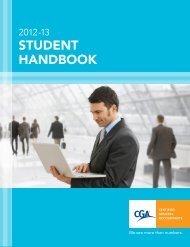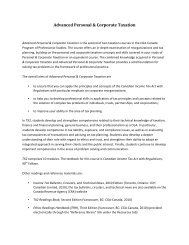Financial Accounting: Liabilities & Equities (FA3) Exam Review
Financial Accounting: Liabilities & Equities (FA3) Exam Review
Financial Accounting: Liabilities & Equities (FA3) Exam Review
Create successful ePaper yourself
Turn your PDF publications into a flip-book with our unique Google optimized e-Paper software.
<strong>FA3</strong> <strong>Exam</strong> <strong>Review</strong> notes Barbara Wyntjes, CGA, MBA, B.Sc.<br />
4 a.<br />
(1) Current service cost $ 150,000<br />
(1) Interest on accrued benefit obligation [(800,000 + 1,200,000) × 10%] 200,000<br />
(1) Expected return on plan assets ($500,000 × 0.11) (55,000)<br />
(1) Amortization of past service cost ($1,200,000 / 8) 150,000<br />
Pension expense $ 445,000<br />
2 b. Accrued benefit obligation as at December 31, 2002 (as per above) $ 2,325,000<br />
4 c. December 31, 2003<br />
(1) Pension expense ........................................................ 445,000<br />
(1) Deferred pension asset.................................................. 445,000 1<br />
(1) Deferred pension asset ............................................ 400,000 1<br />
(1) Cash..... ........................................................................................... 400,000<br />
1 May be combined into one entry<br />
6 d.<br />
(2) The accumulated benefit method calculates the contribution that an employer must<br />
make in order to fund the pension to which the employee is currently entitled, based on<br />
the years of service to date and on their current salary.<br />
(2) The projected benefit/unit credit method calculates the required funding based on the<br />
years of service to date but on a projected estimate of the employee’s salary at the<br />
retirement date.<br />
(2) The level contribution method projects both the final salary and the total years of<br />
service and then allocates the cost evenly over the years of service.<br />
Part 9: Module 8 – <strong>Accounting</strong> Changes<br />
Blueprint: 6-10%<br />
NOTE: Assume IFRS<br />
a. Frank Inc. purchased equipment on January 1, 2000 for $100,000. The company<br />
estimated that the equipment had a 5-year useful life and no salvage value. Frank<br />
amortized the equipment using the straight-line method for 4 years. During 2004, Frank<br />
re-estimated the total useful life of the equipment to be 8 years. What is the amount of the<br />
amortization expense in 2004?<br />
1) $ 2,500<br />
2) $ 5,000<br />
3) $ 8,000<br />
4) $ 12,500<br />
19






